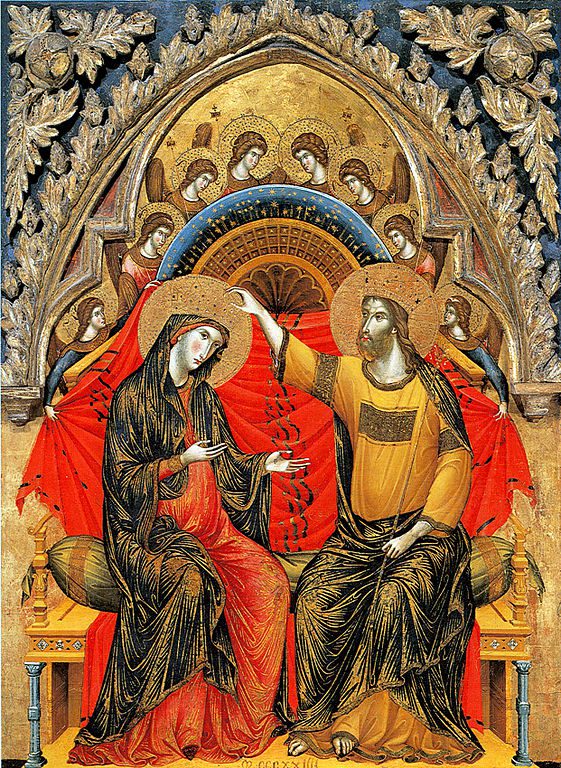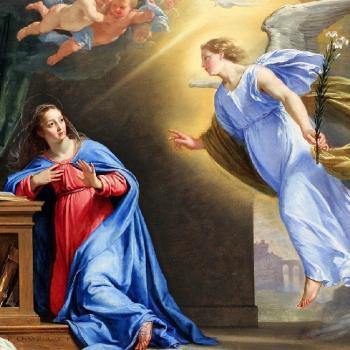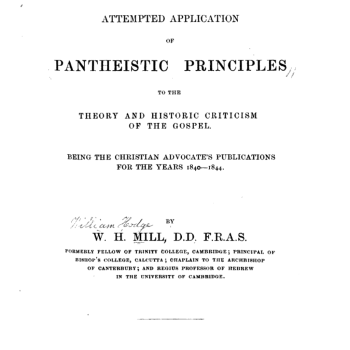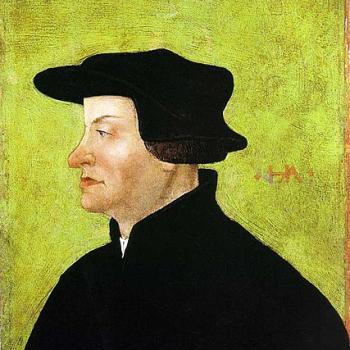
1. to be in an intermediate position or location.
2. to be an intermediary or conciliator between persons or sides.
3. to be the medium for bringing about (a result), conveying (an object), communicating (information), etc.
In the sense of #1, Mary stands between men and God vis-a-vis the incarnation. God needed a human being in order for the incarnation to take place, and so Mary stood in that juncture between God the Father (Spirit) and God the Son (The incarnate God-Man).
I don’t see that #2 applies so much, but #3 is apt, in that Mary was a vessel for Jesus to come into the world. Likewise, Mary could also be a conduit or vessel for the graces won by Christ alone, by His work on the cross and His divine power alone, to be distributed or applied to men. This is what we believe. We see no conflict between that role and Christ’s role, because they are fundamentally different.
To use a crude analogy, say that I go to a gas station. I don’t produce the gasoline, yet in order for it to be effective in my car, I have to stand there and be a “mediator” between the pump and my gas tank. All the gas flows “through” me as the one connecting the pump with my vehicle. Likewise, we believe that God uses Mary in that fashion, to distribute graces not produced by herself but by God. She isn’t the source of the grace anymore than I am the source of the gasoline. This is a biblical notion (generally speaking): Paul and angels are described in similar fashion.
A Protestant dialogue partner stated that union was a more appropriate term to describe the virgin birth. Well, what we are discussing is man’s relationship to God vis-a-vis the incarnation and Mary’s special role in that. Her “union” was with the Holy Spirit, Who overshadowed her in order to bring about the virgin birth.
In other words, it is still a vertical relationship between man and God. And how would that relate to natural conception by a man and woman? The right word to use there is procreation, which means, literally, “to create.” We don’t think that parents create their children, but their role is crucial. They cooperate with God in a — so to speak — “mini-creation,” where God creates the soul supernaturally and the parents produce the “raw material” for the body. There is still an element of the supernatural in every conception, just as there was to a much greater extent in the conception of Jesus.
Parents don’t “create” in the sense of absolute bringing-into-being, but they play a key and crucial role in the entire process. God involves them. Likewise, mediatrix, as applied to Mary is a similar concept. She doesn’t produce the grace she distributes by God’s decree, but God chooses to involve her for that purpose.
I also discovered an interesting biblical parallel. The Greek word for mediator in 1 Timothy 2:5 is mesites. We find that it is also used at Galatians 3:19:
Why then the law? It . . . was ordained by angels through an intermediary.
Kittel’s Theological Dictionary of the New Testament (abridged; p. 588) states about the word as used in this passage:
. . . the law . . . is given by God in order to lead to faith in Christ. But it is ordained by angels through an intermediary . . . The intermediary is no doubt Moses . . . The law, then, does not come directly from God.
So the law had a mediator, and so we find in Scripture that grace also can be passed through a mediator:
Grace to you and peace from him who is and who was and who is to come, and from the seven spirits who are before his throne, and from Jesus . . . (Rev 1:4-5; RSV)
In similar fashion again, in Revelation 5:8 and 8:3-4, we find that the “four living creatures,” the “24 elders,” and an “angel” somehow have intercepted and are in possession of “the prayers of the saints.” They are interceding for those on earth, and acting as mediators between them and God. Thus, this theme is common in Scripture in many different manifestations.
Eve stands between the human race and sin and the Fall. She is in a sense the “mediatrix” of original sin, though the Bible also teaches that “in Adam, all fell,” so that it was in fact all of us in Adam and Eve, not just them screwing it up for everyone else. Conversely, Mary is the go-between of men and God, by saying “yes” to God and His plan of redemption, thus reversing Eve’s “no” and refusal to obey and cooperate with God. This applied, in the patristic use, more to Mary’s role as the vessel of God for the purpose of the incarnation, which in turn brought redemption.
Protestants (or Catholics) won’t find an explicit indication of Mary Mediatrix in Scripture. We believe that is not strictly necessary, because Scripture itself doesn’t teach that every Christian doctrine must be explicit in Scripture. Some can be part of the apostolic deposit and developed in Tradition with the Guidance of the Holy Spirit (which concepts are in Holy Scripture).
The Catholic believes this in faith. It is not a logically airtight proposition. A Protestant may conclude on various grounds that the Catholic Church is correct on a, b, c, and p (as I did before I converted), but to accept the whole ball of wax requires faith, just as faith is required to become a disciple of Jesus or to believe that the Bible is the infallible, inerrant, and inspired revelation from God. Protestants expect error to be found in Catholicism because they don’t believe in an infallible Church. But if a Catholic found a serious error, then he would have to question the system of belief that he has.
My argument (in the paper, A Biblical and Theological Primer on Mary Mediatrix) must not be taken to prove more than it intends to prove. It was basically an exercise in creating what I call a plausibility structure and to show that the notion of Mediatrix is not immediately dismissible as contrary to Scripture in the sense that it blatantly contradicts it.
In no way do I claim that Scripture Alone proves Mary Mediatrix (or Mary’s Assumption or Immaculate Conception, for that matter). What I try to do on my website and in books is to show that Catholicism is not unbiblical or anti-biblical and that its doctrines can be harmonized with Scripture, even though they’re not always able to be proven from Scripture alone. We deny the claims of sola Scriptura so that is no particular difficulty for us.
The sense in which we regard Mary as a sole or unique mediatrix has to do with her preeminent and singular role in the order of grace. We believe that God has chosen to use her in the distribution of all the graces that were won solely by Christ’s infinite merits and work on the cross. She is the only person so honored, just as she is the only Theotokos and Queen of Heaven.
My other examples were lesser analogies, meant to show that mediation per se is not an unbiblical concept, nor contrary to Christ’s sole mediation in terms of Who saves us and produces the grace necessary for salvation (Vatican II makes this crystal clear). I viewed those arguments as the clearing away of the usual roadblocks to acceptance of this notion, not as positive proofs (which are not to be had in Scripture itself).
The medieval Catholic theologians used the metaphor of Mary as the “neck” of the Body of Christ, now subsisting in the Church. Jesus is the Head, of course. We are His Body, and Mary serves as the “neck” through which all the grace which Jesus sends us passes. She is a vessel, just as she was in her role as Theotokos, but of course it is an unfathomable honor to be raised to such exalted heights: as high as one can go, being a creature. And that is yet another reason why we venerate (honor), not worship her.
We must distinguish three things in this often vexed discussion:
1. The doctrine of Mediatrix (aka Co-Redemptrix) itself.
2. The particular words used in describing it.
3. Whether it should be defined ex cathedra, and with what terminology.
I fully accept #1, as a teaching solidly entrenched in authentic Catholic apostolic Tradition and the ordinary magisterium. Documentation is overwhelming, and this cannot be disputed.
I am opposed to #2 (i.e., normative use of the term Co-Redemptrix) and #3, thus I am in full agreement with both Pope John Paul II and Cardinal Ratzinger, and in opposition to Dr. Mark Miravalle. Reasonable people of good will, and equally orthodox Catholics can disagree on this, because that is how the Catholic system works. One can disagree on the timing of a dogmatic definition at the highest levels of Church authority, as I do, and as the Holy Father himself does, without rejecting the teaching itself.
For example, Cardinal Newman took the same analogous position on the definition of papal infallibility in 1870. That doesn’t mean that he disagreed with papal infallibility. He was concerned about a definition which went too far (ultramontanism). But the Holy Spirit prevented that from happening in the First Vatican Council, to Newman’s great delight. He submitted to the definition after it was proclaimed, as an obedient Catholic, and fully agreed with it. I would do the same with this definition, if it occurred.
Much of the confusion in this discussion (as far as I can tell), is with the above crucial distinctions. Some seem to think that “Co-Redemptrix” is some novel, radical innovation of either the liberals or the ultra-conservatives. As for myself, I fall in neither camp, and vigorously oppose both on my website.
I simply agree with the Holy Father and Cardinal Ratzinger. This isn’t a debate about “orthodoxy vs. heterodoxy.” It is about timing and the mind of the Church, just as with the past proclamations of 1854 (Immaculate Conception), 1870 (papal infallibility) and 1950 (the Bodily Assumption of the Blessed Virgin Mary).
There is less consensus on this question than on those. It doesn’t follow, however, that the doctrines themselves are heretical or out of the mainstream. They are not. If they were, in fact, wild divergences from mainstream Catholic Tradition, they could never have even been considered for ex cathedra definition.
The pope opposes definition because of timing and inopportunism, not because the views are a flaming heresy. He has taught them himself, strongly. For example, on 31 January 1985, in an address at the Marian shrine in Guayaquil, Ecuador, Pope John Paul II said:
Mary goes before us and accompanies us. The silent journey that begins with her Immaculate Conception and passes through the “yes” of Nazareth, which makes her the Mother of God, finds on Calvary a particularly important moment. There also, accepting and assisting at the sacrifice of her son, Mary is the dawn of Redemption; … Crucified spiritually with her crucified son (cf. Gal. 2:20), she contemplated with heroic love the death of her God, she “lovingly consented to the immolation of this Victim which she herself had brought forth” (Lumen Gentium, 58). …
In fact, at Calvary she united herself with the sacrifice of her Son that led to the foundation of the Church; her maternal heart shared to the very depths the will of Christ “to gather into one all the dispersed children of God” (Jn. 11:52). Having suffered for the Church, Mary deserved to become the Mother of all the disciples of her Son, the Mother of their unity. …
The Gospels do not tell us of an appearance of the risen Christ to Mary. Nevertheless, as she was in a special way close to the Cross of her Son, she also had to have a privileged experience of his Resurrection. In fact, Mary’s role as Coredemptrix did not cease with the glorification of her Son.
So John Paul II can hardly think that the term Coredemptrix is some hideous manifestation of heterodoxy and disobedience (to himself?), if he uses it himself. That he used it is merely a practice that has continued from his predecessors in the 20th century.
Now, how does Cardinal Ratzinger fit into all this? Well, he simply opposes definition of the particular term, Co-redemptrix. I think he is right about that, and I agree (have written as much on my website for several years now). The term is too misunderstood, and not the best one to use. It has been used less and less by popes for this very reason. That doesn’t make it heretical, though, rightly understood.
I agree with Cardinal Ratzinger and the pope as well. I am in full submission to the Church on this matter, and, in fact, pleased with the decision of the Holy Father to not define the fifth Marian dogma.
Mediatrix is the term used in Vatican II. It is almost as misunderstood by Protestants as Co-Redemptrix, since it is erroneously thought to clash with the notion of Christ as sole mediator of salvation. So that term also requires lengthy clarification and explanation.
Related Reading:
Mary Mediatrix: A Biblical Explanation [1999]
Biblical Evidence for Mary Mediatrix [11-25-08]
Mary Mediatrix: A Biblical & Theological Primer [9-15-15]
Mary Mediatrix? [Collection of papers compiled on 4-6-16]
Exchange on Catholic Mariology and Mary Mediatrix [Facebook, 12-3-16]













